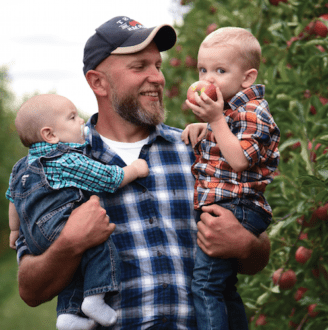

Aug 30, 2021Crunch Time Apple Growers expands acres for club apples
Brett Kast, a fourth-generation grower near the town of Albion in New York state, likes the way that SnapDragon and RubyFrost apples redden and ripen during the middle of the harvest season.
They’re in little danger of a late-season freeze and dodge other issues that early-harvesting varieties have. And the apples naturally grow well because the cultivars were developed in the state by Cornell University.
But Kast and the others in the Crunch Time Apple Growers collective that grows and markets the apples aren’t the only ones who like the apples. He said consumers remain dedicated to the two trademarked apples that first debuted in 2013. The acres of orchards growing the apples, as well as the retail spaces where they are sold, continue to expand.
“I always thought it was just the farmers that would get excited when they knew it was almost time for their favorite variety to harvest,” Kast said. “But folks are excited about it and looking forward to when they can see it again on the stands.”
A growers’ apple
Kast Farms is a diversified operation of about 4,500 acres with crops ranging from apples, cherries, field corn, green beans, sweet corn, wheat, barley and soybeans. The farm grows about 25 acres of SnapDragon and 25 acres of RubyFrost.


As Kast Farms’ orchard manager, Brett Kast has had a chance to see how the cultivars perform. He is a co-owner of the company, along with his brother, John Kast and father David Kast (who is semi-retired). John Kast is the field crop manager.
“Together with our General Manager Gary Davy, the three of us handle day-today operations of the farm,” he said. The fifth generation of growers are well on their way: Brett married Amanda in 2012, and they have two boys, Brantley, 5, and Easton, 3.
Brett Kast said that while any new cultivar comes with its own set of unique challenges, RubyFrost and SnapDragon have been relatively trouble free.
“The conditions that we generally experience during the harvest windows of RubyFrost and SnapDragon lead to optimal color and flavor development,” he said. “The ability to not have to ‘adapt’ our growing conditions to make these two varieties work certainly is a big advantage.”
Kast has put some thought into which rootstocks work best with the cultivars.
“So, the RubyFrost is a ‘tip bearer’ with growing habits similar to a Rome or Cortland apple,” he said. “It does have fire blight sensitivity during its vegetative development stages. Once the tree enters production and settles down, the fire blight becomes much less of an issue. So putting it with a rootstock that will help the tree fill its space, but not continually push excessive vigor through the life of the tree is important in this cultivar. New York has a lot of diversity in site conditions and just because one rootstock performs well in one area, doesn’t mean that it is well suited for the neighbor down the road. But in general, I would say that a B.9 would be too weak for a RubyFrost. Even if production was held back and the tree allowed to fill its space, once the tree was fully cropped, the growth in the tree would shut down completely. And being a tip bearer, that tree would weep and not be as productive as it could be. A G.935 or an M.337 on the other hand, might be a bit strong for this variety early on and so in my personal preference something along the lines of a B.10, N.29, G.41 would be good examples of what to look for.”
SnapDragon, in contrast, does require more of a “push” from its rootstock.
“A G.935 wouldn’t be a bad choice here,” Kast said. “I’m speaking in familiar examples of what kind of vigor the cultivar needs from the rootstock to fill space and reach full production without major issues. There are other options that certainly could be considered as far as efficiency, but these are examples of what strength of vigor to consider.”
Expanding acres
Crunch Time Apple Growers has 152 grower-members who together represent about 60% of New York State’s apple production. Jessica Wells, executive director of Crunch Time, said that while the company isn’t signing on new commercial growers, many more acres of already-planted orchards will soon reach maturity.


“There are currently just under 1,000 acres of SnapDragon in the ground or planned in the next year or two, with around 630 acres currently in production,” she said. “There are approximately 325 acres of RubyFrost in full production, with another 25 that will reach their peak in the next couple years. We offer additional acreage to our existing commercial grower base on a very limited basis, based on retail demand.”
While the variety was bred for New York growers, the company has shown a willingness to share with others outside the state.
“Last year we began to allow direct-market growers outside of New York state to plant and market SnapDragon and RubyFrost; we had 19 growers in 11 states sign on as a part of this program,” Wells said. “We anticipate allowing commercial growers outside of New York state to plant the varieties at some point in the future but it will be dependent on demand and the
ability to market the additional fruit that would be grown.”
Popular demand
Kast said consumers are excited about the apples. RubyFrost’s taste is described in marketing materials as “the perfect balance of sweet and tart, deep and rich with a hearty crunch and ideal crisp texture,” while SnapDragon is “a snappy texture and sweet, juicy flavor.”
“We do not personally have a farm market, but we do work with several in the area,” he said. “RubyFrost certainly has a strong following and a loyal customer base. They like the tartness and its diversity for use. SnapDragon is quickly outperforming Honeycrisp in a lot of markets. It is one of those apples that provides the consumer with a special, unforgettable eating experience. It is at a very exciting stage right now, where people are discovering it. Once a market can get a SnapDragon apple into a consumer’s mouth, that customer is coming back for more.”
While the apples are available in a variety of packs, depending on what retailers need, Wells said the “best-selling pack style is currently the 2-pound pouch.”
Crunch Time Apple Growers in July 2021 announced an agreement allowing Gardners, Pennsylvania-based apple packer Rice Fruit Co. to market both SnapDragon and RubyFrost apples for the 2021 harvest. Rice Fruit Company has more than 100 years of experience in the apple packing industry and grower partnerships have expanded with more than 40 farm families in the surrounding areas.
“SnapDragon and RubyFrost are both valuable contributors to the industry-wide effort to keep the apple market energized and exciting for shoppers,” Rice Fruit Co. President Ben Rice said in a news release. “We are thrilled to be included in this group of talented organizations and to make these delicious apples available to our customers.”
Wells said existing partnerships both with growers and with retailers are two of the key reasons Crunch Time opted to enter into an agreement with Rice Fruit Co. Rice already has partnerships with several growers that grow SnapDragon and RubyFrost and has retail customers who are not currently offering either variety. There’s no exclusivity in the Rice Fruit deal, and Crunch Time currently works with seven other shippers/packers, including United Apple Sales, Niagara Fresh, Fowler Brothers, Apple Acres, Hess Brothers, Hudson River Fruit Distributors and New York Apple Sales, she said.
“We prefer to take a team approach based on the way many retailers operate logistically and by having multiple partners we’re able to distribute to a broader range of retailers,” Wells said. “We expect that the partnership with Rice Fruit Co. will grow sales with a few key retailers mostly in our existing geographic footprint – primarily the East Coast,” she said.
Kast was upbeat on customer demand and cautiously optimistic about the 2021 harvest.
“Folks are excited about it and looking forward to when they can see it again on the stands,” he said. “I might be a bit superstitious (about the harvest) and not willing to count the chickens before they’ve hatched, but I will say this: The customers aren’t the only ones excited about what is hopefully to come this fall.”
— Stephen Kloosterman, associate editor; Photo at top: RubyFrost reaches its peak flavor in the winter months and works well as a baking apple as well as fresh, according to marketing materials for the apple. Courtesy of Crunch Time Apple Growers.














